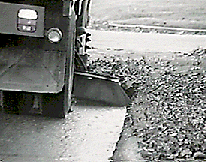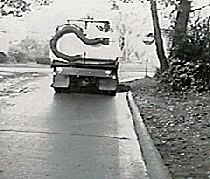Leaf Season: Municipal Headache

Getting them up is only half the problem...
then there's disposal
by Ranger Kidwell-Ross
Once again it's leaf season, a dreaded time of year for many city managers and contractors. It's too late to change what you do for this year, but now is the time to be considering your options for next year and the years to come. You'll find that options chosen by cities vary widely.
Tony Palanski, Public Works Director for Sheridan, Wyoming, has been with the department for 25 years. "For probably 15 years before I got here," he says, "the city has allowed our residents to sweep all their leaves into the street. This includes even those from their back yards. As soon as there is a sufficient amount we start picking them up. It takes about six weeks to get them all up, and this is at no charge to the residents. We just absorb it in our taxes.
"We start out by using our sweeper. We've had a Tymco 600 and now have gone to an Aaplex 7000. One of the advantages with the Aaplex is their leaf bleeder system, which allows suction to be adjusted for easier leaf pickup. That really makes a big difference.
"Once the leaves pile up to the point where a sweeper can't handle them, however, we switch to a Vactor. With either sweeper or Vactor, when we get a load we deliver it to an area resident as compost instead of taking it to a landfill. We have more people who want the leaves than we have them to deliver.
"In Sheridan we also pick up grass clippings and garden waste with a separate garbage truck, then take them to a compost area at our city landfill. The city uses this compost in its own grounds maintenance program, and that is a big saver of landfill space."
David Mink, Superintendent of Public Works in Overland Park, Kansas, says their city takes the opposite tack during leaf season. "We don't have a leaf pickup program, and I don't know that anyone is even talking about one. People are supposed to bag leaves up for garbage collection, but a lot of people just rake them right out into the street in big piles.
"Our mandate is to sweep residential areas three times a year, and we actually try to be done by the end of September or early October before the leaves start to fall. Then we don't go back until April of the next year when the leaves have decomposed and the snowplows have worked them over enough that they can be dealt with.

"We have four sweepers: an Elgin Eagle, a Johnston Vanguard 4000, an FMC 4-wheel broom machine and a Tymco 600 regenerative air sweeper. We find leaves to be a huge problem, because the sweepers are not designed to pick them up. That's why we just try to get our street sweeping done before the leaves come down, so we can avoid them. The residents have a hard time understanding why we don't have a sweeper that is designed to pick up leaves, though.
"We do collect the leaves around the catch basins, so we can keep the water running. Because most of the leaves stay on the street to decompose, however, clogged storm water systems are also a problem. We have to go out a lot in the winter months and keep them open."
Leaf season is also considered a real problem time for the city of Tulsa, OK. Roman Albert, Jr., President of Tulsa-based Lot Maintenance, Inc., reports that he was the only contractor to bid on the city's leaf sweeping this year. "Basically, we increased our price by 300%. We went from $35.00 a mile to $90.00 per mile for a 5 month contract from September to February. Here, that is basically when we're doing just leaf sweeping.
"The city rejected the bid, which is fine because I don't want it for less. Not only do we have to take the leaves, but we have to get the crabgrass out of the cracks along the curbline. To remove it from the curbline we actually found ourselves using a snowplow to scrape it! The areas holding the grass are already deteriorated to begin with, so asphalt comes out as well and it is a real mess.
"We usually have to double sweep, too, because of the quality standards required. The $90.00 a mile bid is not an unreasonable one when double sweeping and all the other costs with that are considered. We run the air machine and then the broom machine, or then vice versa depending on how heavy the areas are. We're getting 5, 6, 7 yards of material a mile, so there's quite a disposal cost. The bid was where it needed to be.
"Another part of the equation is that because it's leaves, we get callbacks all the time. As I told the city, the first 90% costs half of the amount, and the last 8% costs another half. I had a renewal on my contract from last year, and I chose not to do it. Instead I said let's rebid. It says something that the big guys, Waste Management and BFI, weren't even interested in bidding the leaf season work.
"The city director is in the process of calling around the US to see what sweeping costs are in other places, to educate themselves. Disposal is another issue: they wanted me to lock in my price for five years, but what if they reclassify these leaves in two years? What if they reclassify the dirt coming off the curb line from the arterial? The disposal cost right now is $5.50 per yard but what if it goes to $35.00 per yard? I think the only realistic option in municipal contracts is to have escalation costs for disposal. How can we not require that?"

Gary Almy, Maintenance Superintendent for Bellingham, Washington, said that in the northwest "sweeping leaves is a big problem. Piles go from 2 inches deep in one place to 2 feet deep in another, and some of the piles are wet while others are dry. It's very difficult to find a machine that will do a good job.
"In fact, when we were in the market recently for a new sweeper, we invited all the major manufacturers in for an initial testing process, to see how they would do under general conditions. Then, we brought the two top finishers, the Tymco 600 and Aaplex 7000, in to sweep leaves. We ended up choosing the Aaplex, even though a Tymco 600 was what we had currently. It did a better job with leaves and didn't leave debris on the ground when the head was picked up.
"In our central business district, wh we sweep three nights a week, we tell them to put their leaves onto the street. Area residents aren't supposed to, but of course we get a certain percentage anyway. In the residential areas with the most leaves, we sweep either every week or every other week during our two month leaf season. Because we stay on top of it, we have always been able to do the job with our sweepers.
"Our biggest problem is not pickup, but rather disposal. We haven't even been able to empty our catch basins for over a year because there has been nowhere to take it. We just put out an RFP for disposal of catch basin, ditching and sweeping material. It looks like long haul is going to be our only option, at a cost of $70 a ton. That doesn't even include a settling and evaporation facility. Whatever the final amount, it will no doubt be very expensive, as well as come right out of the pockets of the people in our community."
This article is reprinted from American Sweeper magazine, v4 n2.
|